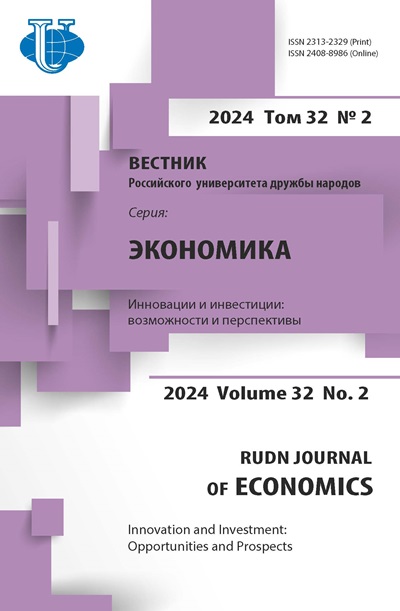Европейская интеграция и голландская болезнь: Португалия и Испания
- Авторы: Андраде Ж.С.1, Дуарте А.П.1
-
Учреждения:
- Университет Коимбры
- Выпуск: № S5 (2013)
- Страницы: 214-222
- Раздел: Статьи
- URL: https://journals.rudn.ru/economics/article/view/11982
Цитировать
Полный текст
Аннотация
Португальская и испанская экономики получили крупные суммы из европейских структурных фондов и воспользовались значительным сокращением процентных ставок по кредитам после вступления в ЕС. Совокупное воздействие этих двух факторов привело к возникновению эффекта, сравнимого с так называемой голландской болезнью. Приток финансовых средств в данном случае можно рассматривать как своего рода проклятие. В статье мы показываем наличие голландской болезни в португальской экономике и ее отсутствие — в испанской. Проведя описательный анализ некоторых переменных, мы рассмотрели всю совокупность необходимых для расчетов уравнений, в которых были учтены прямые и непрямые последствия притока средств из структурных фондов и финансовых издержек для экономики. При этом было выявлено, что воздействие этих факторов на реальный валютный курс сыграло основополагающую роль.
Ключевые слова
Список литературы
- Acosta P., Lartey E.K.K., Mandelman F.S. 2009. Remittances and the Dutch disease. Journal of International Economics, 79, 102—116.
- Adams C. 2006. Exogenous Inflows and Real Exchange Rates: theoretical quirk or empirical reality? In: Isard P., Lipschitz L., Mourmouras A. & Yontcheva B. (eds.) The Macroeconomics Mangement of Foreign Aid: Opportunities and Pitfalls. Washington DC: International Monetary Fund.
- Allen M. 2005. The Macroeconomics of Managing Increased Aid Inflows: Experiences of Low-Income Countries and Policy Implications. International Monetary Fund.
- Bayangos V. & Jansen K. 2011. Remittances and Competitiveness: The Case of the Philippines. World Development, 39, 1834—1846.
- Buch C.M., Kuckulenz A. & Manchec M.-H.L. 2002. Worker Remittances and Capital Flows. Leibniz Information Centre for Economics, Kiel W.P., 1130.
- Checherita C., Nickel C. & Rother P. 2009. The role of fiscal transfers for regional economic convergence in Europe. Working Paper E.C.B., 1029.
- Clements K., Lan Y. & Roberts J. 2008. Exchange-rate economics for the resources sector. Resources Policy, 33, 102—117.
- Corden W.M. 1984. Booming Sector and Dutch Disease Economics: Survey and Consolidation. Oxford Economic Papers, 36, 359—380.
- Corden W.M. & Neary J.P. 1982. Booming Sector and De-Industrialisation in a Small Open Economy. The Economic Journal, 92, 825—848.
- Crespo T. & Nascimento M. 1997. Estatísticas Monetárias e Financeiras. In: Pinheiro M. (ed.) Séries Longas para a Economia Portuguesa, pós II guerra mundial, Vol. I. Lisboa: Banco de Portugal.
- DGAE/MNE 2012. Informação Estatística, União Europeia — Estados Membros, Lisboa, Direção dos Serviços das Questões Económicas e Financeiras.
- Dreher A. 2006. Does Globalization Affect Growth? Evidence from a new Index of Globalization. Applied Economics, 38, 1091—1110.
- Dreher A., Gaston N. & Martens P. 2008. Measuring Globalisation — Gauging its Consequences, New York, Springer.
- Drelichman M. 2005. The curse of Moctezuma: American silver and the Dutch disease. Explorations in Economic History, 42, 349—380.
- ETH. 2012. KOF Index of Globalization [Online]. globalization.kof.ethz.ch/.
- EUROPEAN_COMMISSION 2012. AMECO Database, Annual Macro-economic Database. ec.europa.eu/economy_finance/db_indicators/ameco/.
- Gelb A.H. & ASSOCIATES 1990. Oil Windfalls: Blessing or Curse? A Comparative Study of Six Developing Exporters, New York, Oxford University Press.
- Godinho V.M. 1968. Portugal, as frotas do açucar e as frotas do ouro (1670—1770). In: COSTA, S.D. (ed.) Ensaios II, Sobre a História de Portugal. Lisboa: Vitorino Magalhães Godinho.
- Gregory R.G. 1976. Some Implications Of The Growth Of The Mineral Sector. Australian Journal of Agricultural Economics, 20, 71—91.
- GRONINGEN GROWTH AND DEVELOPMENT CENTRE 2011. EU KLEMS Growth and Productivity Accounts, NACE 2. www.euklems.net.
- Gupta S., Powell R. & Yan Y. 2005. The Macroeconomic Challenges of Scaling Up Aid to Africa. IMF W.P., 05/179.
- Gylfason T. 2001a. Lessons from the Dutch Disease: causes, treatment, and cures. Institute of Economic Studies W.P., 6.
- Gylfason T. 2001b. Natural Resources, Education and Economic Development. European Economic Review, 45, 847—859.
- Hendry D. & Krolzig H.-M. 2003. New developments in automatic general-to-specific modeling. In: PRINCETON (ed.) Econometrics and the Philosophy of Economics: Theory-data Confrontations in Economics. Princeton University Press.
- Hendry D. & Krolzig H.-M. 2005. The Properties of Automatic GETS Modelling. Economic Journal, 115, C32-C61.
- Kang J.S., Prati A. & Rebucci A. 2012. Aid, Exports, and Growth: a Time-Series Perspective on the Dutch Disease Hypothesis. Review of Economics and Institutions, 3.
- Loser C., Lockwood C., Minson A. & Balcazar L. 2006. The Macro-Economic Impact of Remittances in Latin America-Dutch Disease or Latin Cure? Presented at the G-24 Technical Group meeting in Singapore on September 13—14, 1—31.
- Neary J.P. 1985. Real and Monetary Aspects of the 'Dutch Disease'. In: Jungenfelt K. & Hague D. (eds.) Structural Adjustment in Developed Open Economies. New York: St. Martin's Press.
- Rajan R. & Subramanian A. 2005. What Undermines Aid's Impact on Grwoth? IMF Working Papers, 05/126.
- Rajan R.G. & Subramanian A. 2011. Aid, Dutch disease, and manufacturing growth. Journal of Development Economics, 94, 106—118.
- Ross M.L. 1999. The Political Economy of the Resource Curse. World Politics, 51, 297—322.
- Sachs J. & Warner A. 1995. Natural Resource Abundance and Economic Growth. NBER W.P., 5398.
- Sachs J. & Warner A. 2001. The Curse of Natural Resources. European Economic Review, 45, 827—838.
- Sell F.L., Greiner U.W.E. & Maab H. 1999. The East German Disease Revisited. IAER, 5, 153—166.
- The Economist 1977. The Dutch Disease. The Economist, 82.83.
- Torvik R. 2002. Natural Resources, Rent Seeking and Welfare. Journal of Development Economics, 67, 455—470.
- Wijnbergen S.V. 1984. The “Dutch Disease”: A Disease After All? The Economic Journal, 94, 41—55.
- Ye Q. 2008. Commodity booms and their impacts on the Western Australian economy: The iron ore case. Resources Policy, 33, 83—101.














